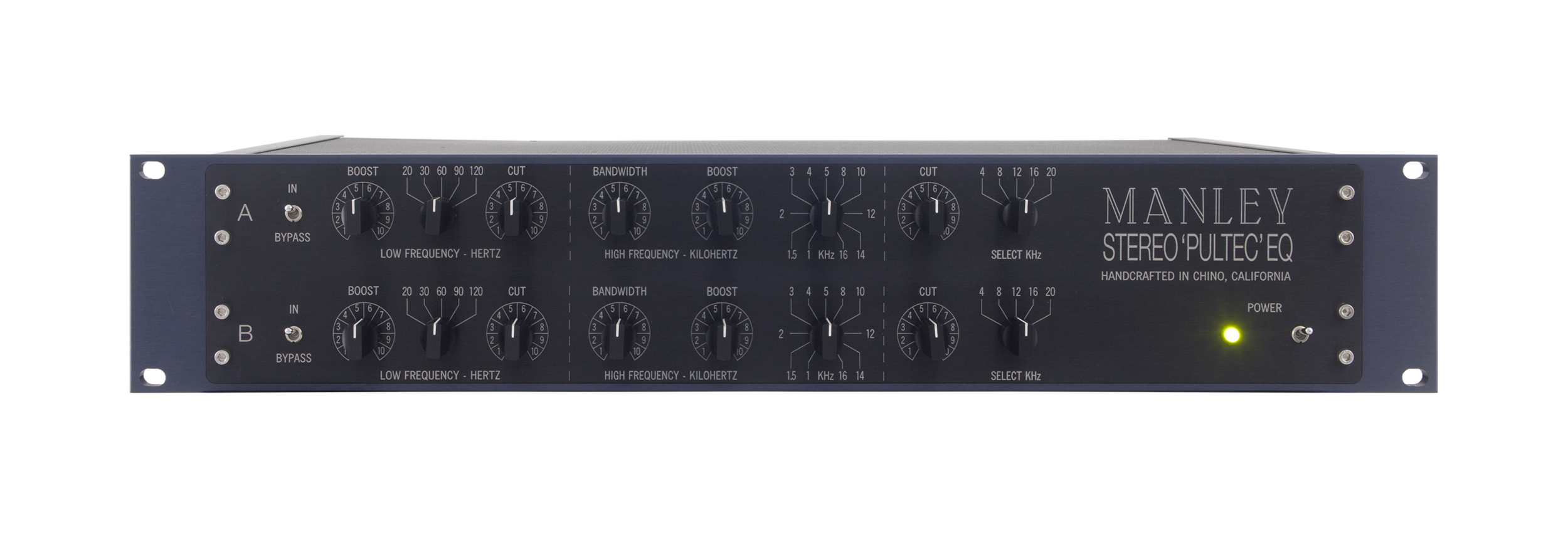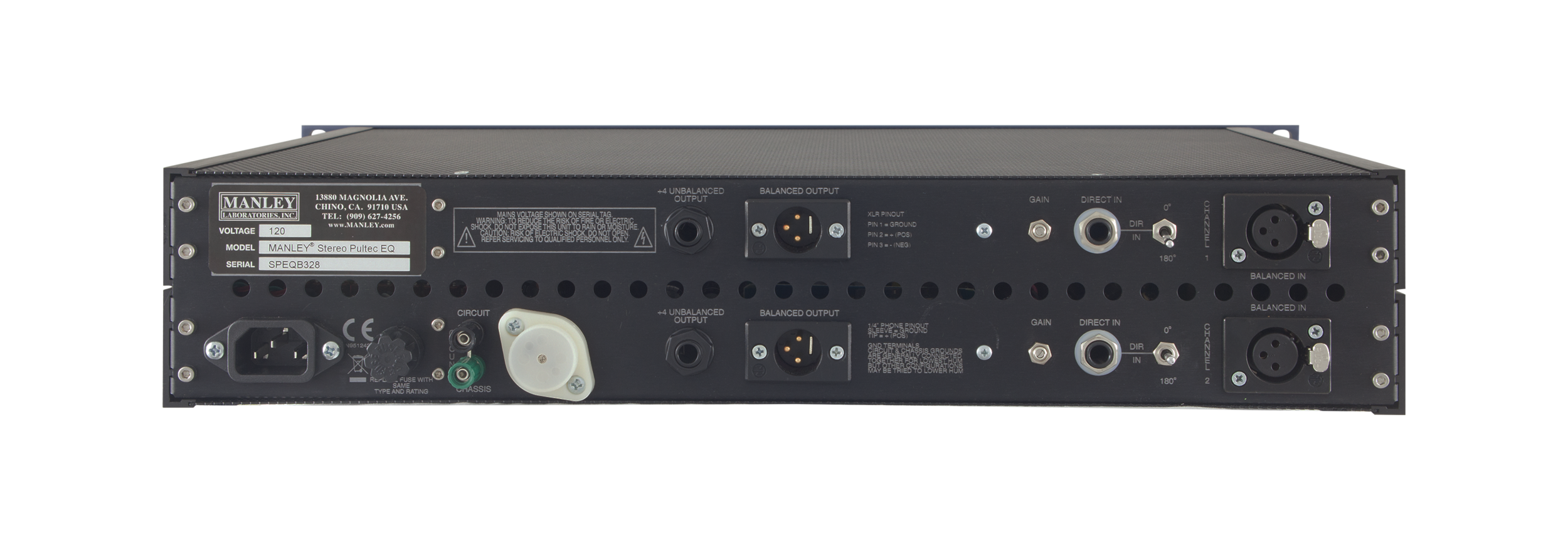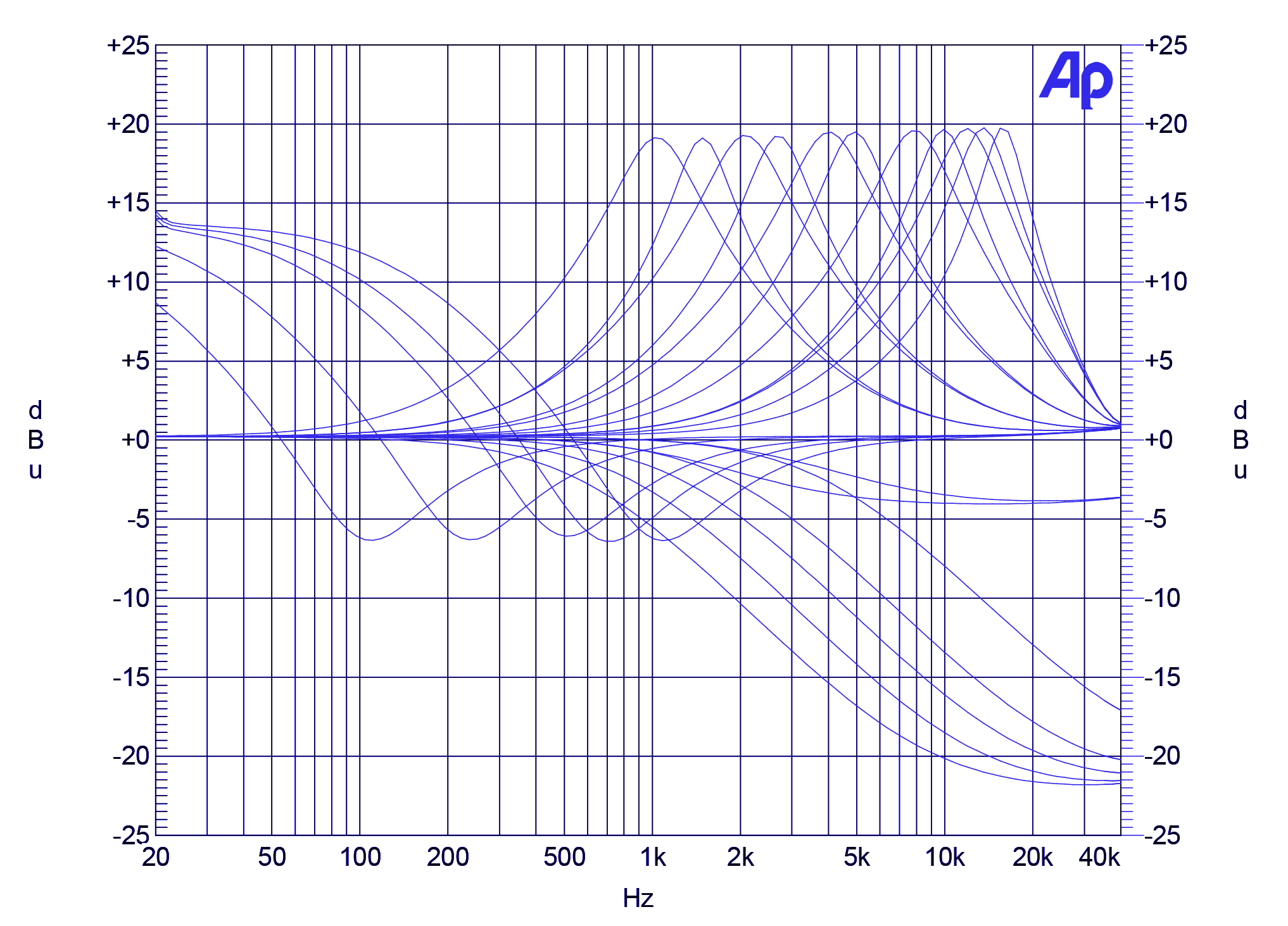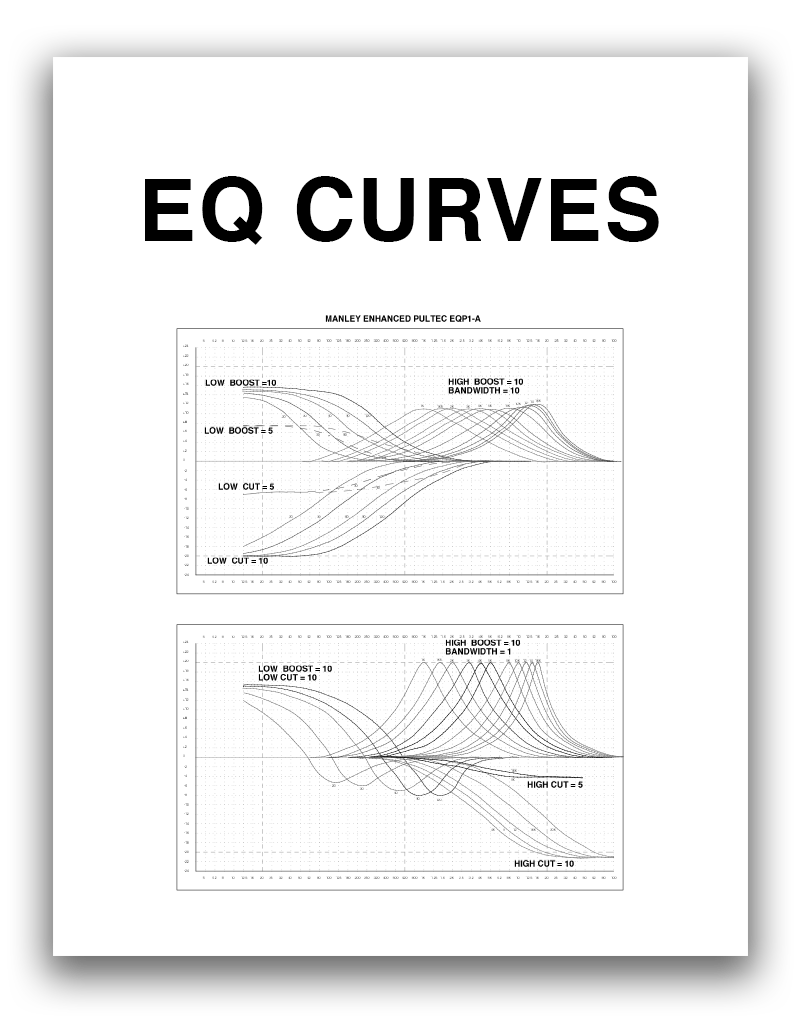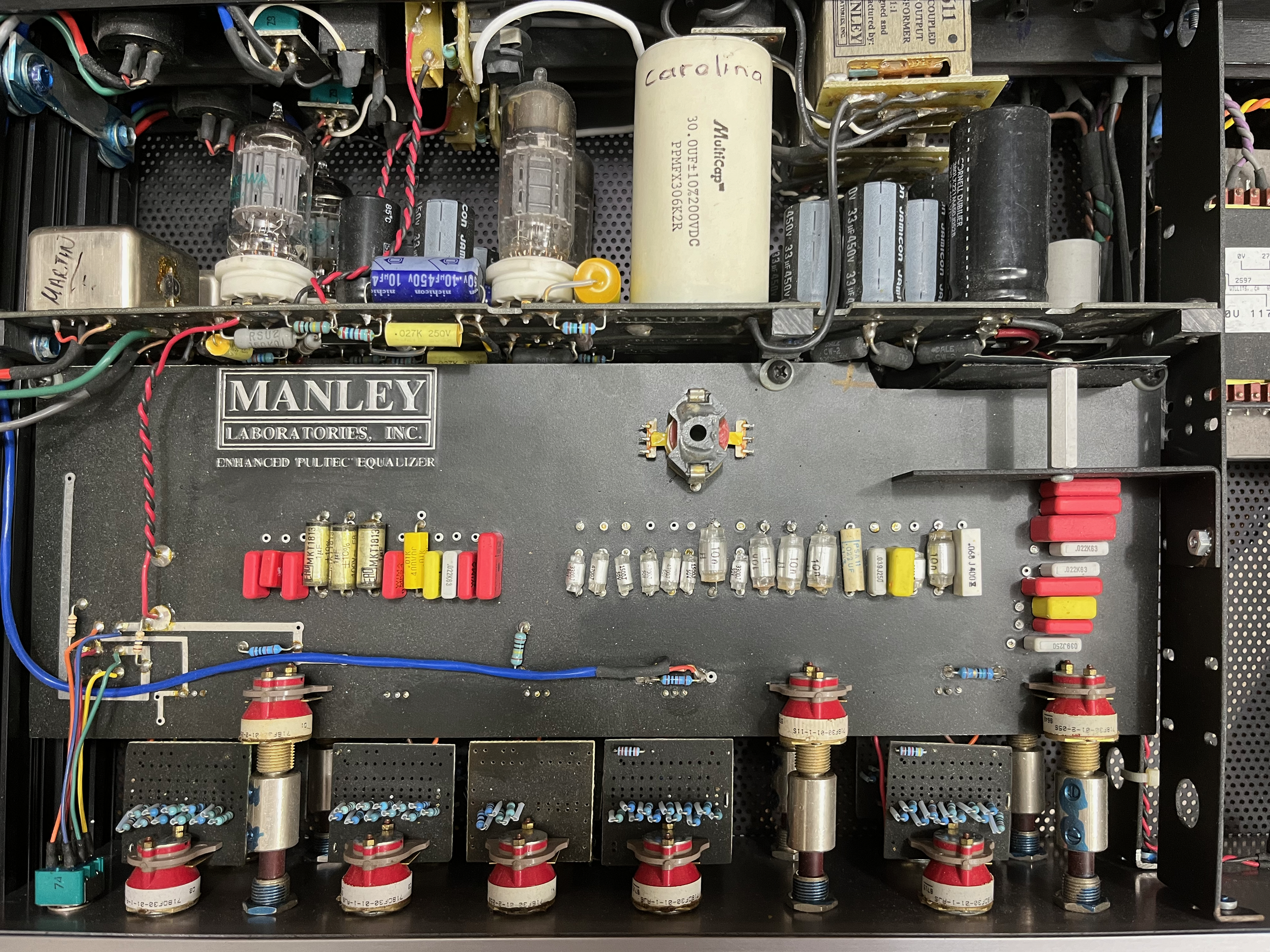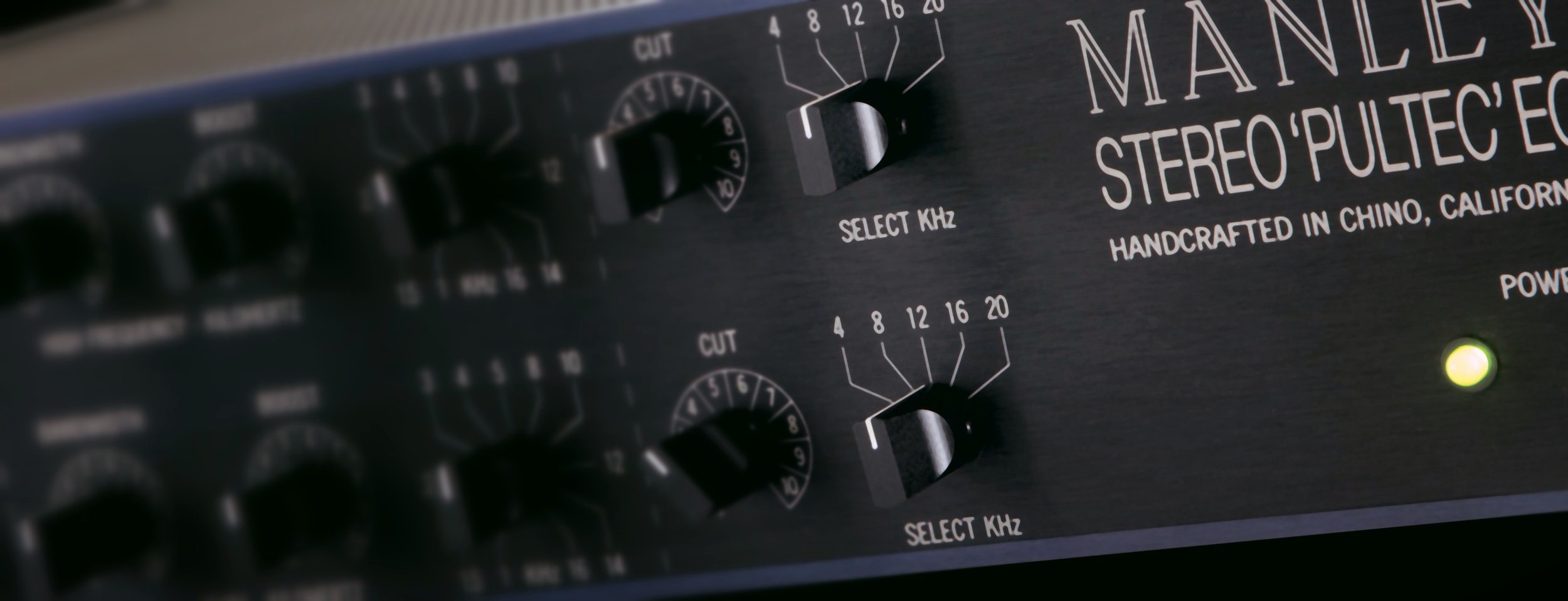
Manley’s modern take on the Pultec EQ - in stereo! - with extra frequencies the original never had; a vastly superior power supply and famous Manley line amps complete the package. Magic on drums, killer on guitars.

DETAILS
The MANLEY ENHANCED PULTEC EQP-1A is our own interpretation of the historic Pultec Equalizer as originally produced by Pulse Techniques, Inc. We have been building these Manley Pultec EQs since 1990 after we bothered to hunt down Eugene Shenk in New Jersey to ask for his permission and blessings to produce our own version of his classic piece. These Manley Pultec units employ our own simple and clean all-tube make-up gain block to reamplify the signal after the passive EQ circuit. EQ may be set to 'flat' positions or BYPASSED entirely. All BOOST and CUT controls are continuously variable conductive plastic potentiometers for absolutely silent operation and long life. Our single rack unit monoblocks occupy one-third of the space of the 'antique Pultecs', an important consideration for allocation of outboard rack space. And if you notice, we've added a couple extra frequencies too. The rear mounted input switch selects 0 degrees or 180 degrees PHASE INVERT for the balanced gold pin XLR input or the transformerless unbalanced bridging input (1/4" jack) may be selected in that switch's middle position.
People often ask us if our Pultec EQ's sound like the old ones to which we reply, "Yes! But better!" The originals had three transformers in the signal path whereas ours can be used completely transformerless. Our Manley Enhanced Pultec has a vastly superior B+ power supply, with regulated and balanced heater supply. Our line amp is known to be killer-sounding. The components we use today just weren't available in the 1960's. So, if you want a project with crackling carbon pots, dirty open frame wafer switches, 5% and 10% tolerance noisy carbon resistors, exposed tubes sticking out the back of the 3U chassis, etc., go pay top dollar for an antique Pultec!
The MANLEY PULTEC EQP-1A, available in both single and 2-channel versions, uses 1 x 12AX7WA and 1 x 6414 (or 5965) in our ALL-TUBE single-ended line amplifier for the gain make-up and extra-beefy sound; gain is factory set for unity but additional gain is available by a rear mounted feedback adjustment trimpot. Like our 40dB Mic Preamps, the Manley Pultecs offer both transformer coupled balanced and direct capacitor coupled unbalanced outputs for easy interface and sonic variety. Kick drum? Bring on the Pultecs and all the iron you can muster! You'll soon discover the power and magic of having those individual Low Frequency BOOST and CUT controls in that LF shelf circuit. . . Need a little clarity or extension? Try that middle bell-shaped Boost dialing in the sharpness of the boost on the BANDWIDTH control. Something bugging you? Ease it off with the HF shelf cut. You'll see. There's no substitute for a what a Manley Pultec EQ can do!
This set of EQ curves shows what happens when you perform BOOST and CUT operations separately.
This set of EQ curves shows the effects of performing BOOST and CUT at the same time, where a DIP is introduced and a BOOST might sound like a CUT!
STEREO PULTEC EQP-1A VIDEOS
SPECIFICATIONS
MANLEY input transformer with nickel laminations potted in mu-metal case.
3 kOhm input Z
PHASE REVERSE switch for balanced XLR input
Alternate transformerless 1/4" HI-Z (5K Ohm) input
BYPASS switch & AUTO-MUTE w/warmup delay
Silent conductive plastic BOOST & CUT controls
Sealed gold-contact Greyhill frequency select switches
Vacuum Tubes: 2 x 12AX7 (gain) and 2 x 12BH7 (or 6414 or 5965) White Follower
Hi-current drive <50 Ohm LO-Z XLR & 1/4" outputs
Balanced Transformer-Coupled XLR Outputs via MANLEY 9611
Flat frequency response from 10Hz-70KHz
<0.01% THD @ 1kHz
S/N Ratio: 116 dB
Adjustable FEEDBACK / GAIN: Unity ±5 dB
Max. output: +30 dBv
Power consumption: 25 Watts
Operating mains voltage: Units are purpose built for original destination country's mains voltage: 100V, 120V, or 220-240VAC as indicated on the serial number badge. Power transformer must be replaced in order to change mains operating voltage. 120VAC units may NOT be rewired to put the primaries of the power transformer in series for 220-240V operation or a large radiated field of hum will develop. If changing locations/voltages, the power transformer must be replaced with the dedicated one for the voltage at which it will operate.
Mains Voltage Frequency: 50~ 60Hz
Dimensions: 19" x 3 1/2" x 10" (occupies 2u)
Unit weight: 12 lbs.
Shipping weight: 17 lbs.

DOWNLOADS
HISTORICAL NOTES
We started building these MANLEY Enhanced Pultec EQ's in 1990 back at the old Vacuum Tube Logic of America factory. They were built there from 1990 until 1993 when the MANLEY LABS factory opened. The serial codes for those old early 1990's units are usually seen as hand-written ENHPLT###. Those oldest units use 5814 input tubes and 6350 output White Follower tubes. There is no substitute for a 6350! Unless you re-wire and swap pins 2&3 and 7&8 then you must keep using 6350 which is wired that way. Those old units also used ElectroSwitch brand NONshorting switches which are brass and black and white in body-of-the-switch color. They make some noise when switch position is changed. They should have been ordered as SHORTING switches. Newest units built at Manley Labs use shorting Grayhill brand switches. Grayhills have red bodies if you look at them.
Much has improved since those early days... Here is what we think was the very first Manley Pultec built in 1990 for BOP Studios in South Africa.
Here is one Mastering Version Stereo Pultec custom built for a customer in October of 1997. You can see we made the chassis extra deep to accommodate the Grayhill switches. These provided 0.5dB steps of Boost and Cut (with BW to minimum on the middle band.)
FREQUENTLY ASKED QUESTIONS
This thing isn’t working. I just bought it. For this amount of money, it needs to function.
OK, listen up: the XLR INPUTS and XLR OUTPUTS are TRANSFORMER-COUPLED so that means you HAVE TO have something connected to all of the pins.
PIN 1: GROUND
PIN 2: HOT (+) POSITIVE
PIN 3: COLD (-) NEGATIVE
You cannot "float" Pin 3. You can GROUND it if you are driving it from an unbalanced source. But you cannot hook it up to "nothing".
Pay attention when interfacing with some of these interfaces like your Apollo. If you are using TRS - XLR cables, make sure that it is wired:
TRS TIP = HOT (+) to XLR Pin 2
TRS RING = COLD (-) to XLR Pin 3
TRS SLEEVE = GROUND to XLR Pin 1
or
TS - XLR cable, make sure it is wired:
TS TIP = HOT (+) to XLR Pin 2
TS SLEEVE = GROUND to XLR Pin 1 AND Pin 3

